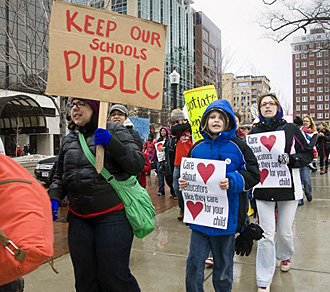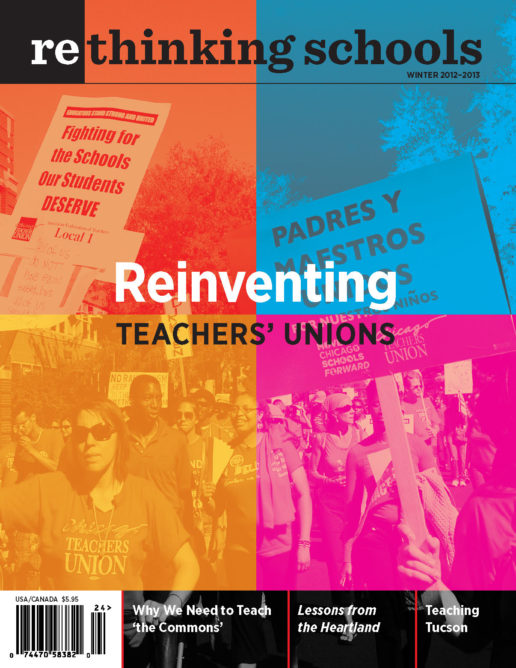Lessons from the Heartland
Illustrator: Barbara J. Miner

Wisconsin – and, in particular, urban Milwaukee – has been at the forefront of a half-century of public education experiments, from desegregation and “school choice” to vouchers and charter schools. Lessons from the Heartland: A Turbulent Half-Century of Public Education in an Iconic American City by Barbara J. Miner, former managing editor of Rethinking Schools, is both a narrative portrait of the struggles for equitable education in Milwaukee, and an exploration of the larger issues of race and class. This excerpt is an adaptation of chapters 17 and 25 (The New Press, 2013).
Vouchers Pass, Abandonment Begins
The long, painful, and conscious abandonment of Milwaukee’s public schools began in September 1990. Publicly funded vouchers for private schools evolved from conservative dream to on-the-ground reality.
Like most people, I didn’t give vouchers much thought when the Wisconsin Legislature passed the program. Vouchers were promoted as “choice” for poor people, an experimental effort under which public dollars would pay the tuition at a handful of private, nonreligious community schools serving a couple of hundred poor children. It seemed worthwhile and noncontroversial, akin to throwing a few dollars in the missionary collection basket at Sunday church.
My first encounter with vouchers, on Nov. 14, 1990, was unexpected but enlightening.
It started as just another day as I dropped my two daughters off at daycare, changed my focus from harried single parent to no-nonsense journalist, and walked into my job at the Milwaukee Journal metro desk. As a general assignment reporter, I was never quite sure what would come my way—perhaps a weather story, perhaps an overnight shooting, perhaps a human interest feature.
I ate the peanut butter and jelly sandwich that passed for breakfast, downed some coffee, and got ready for my day’s assignment. The city editor, a gray-haired Irishman who filled every stereotype of the gruff, disheveled newshound, called me over. I was to go to Bruce Guadalupe School, one of the community schools receiving vouchers, and give an on-the-scene report on daily life at a voucher school.
I headed off to Bruce Guadalupe, located in an old parish school on the South Side, its brick exterior walls bearing testament to years of smoke from nearby factories. I decided to sit in on a 7th-grade reading class, where students were studying vocabulary.
Constancies Morales, 13, groaned as she tried to use the words reticent and benignly in the same sentence. She was stumped. Her teacher tried to come to her rescue. “One word sort of means ‘shy.’ The other means ‘kindly,’” the teacher prompted. It didn’t help. Connie was allowed to move on and try again later.
The class brought back memories, and I was quickly transported back to my own education decades earlier. As I reported at the time, “It was a typical reading class for Connie. In some ways it could have been a typical class for thousands of other children across Milwaukee.”
There were only 13 students in Connie’s class, one reason she liked the school. “Indeed,” I wrote, “the key features of her school are not radically different from reforms mentioned for public schools: small class sizes, parental involvement, high expectations, and a positive school spirit.”
As I found out, however, not all staff shared the “positive school spirit.” In between classes, several teachers approached me with vague stories of turmoil and tension. They couldn’t say more, they said, because they feared for their jobs. The principal was equally upset and vague. The teachers advised that I attend the parent meeting scheduled for the following evening.
I wrote my story, without the unsubstantiated claims of turmoil, and my editor agreed that I should attend the parent meeting. The night of the meeting, I walked up the school steps, reporter’s notebook in hand, ready to get the story. I immediately found my way blocked by a somewhat beefy lawyer physically barring me from the meeting’s door. He told me that Bruce Guadalupe was a private school, this was a private meeting for parents, and I would not be allowed to attend.
I huffed and I puffed, citing the power of the press and arguing that Bruce Guadalupe was receiving public dollars and thus was subject to Wisconsin’s open meetings and records legislation. No, the lawyer explained, Bruce Guadalupe was a private school and I could not enter the meeting. He made it clear that he was prepared to call the police.
I returned to the newsroom and vented to my editor about what had happened. He got in touch with the Milwaukee Journal’s lawyers. Before long, the opinion from the paper’s lawyers filtered down. The voucher legislation did indeed define the schools as private. The Bruce Guadalupe lawyer was right. The public and the media had no right to attend the school’s parent meetings.
I never did find out what happened at that parent meeting. But within two weeks, the nonprofit agency overseeing the school announced that the teaching staff would be slashed by a third, classes would be combined, and the bilingual program would be cut in half. The much beloved small classes I had written about were financially unsustainable. Within another two weeks, the principal was gone.
“We Don’t Open Our Files to Anybody.”
It was the first but certainly not the last time I ran up against voucher schools refusing to provide basic information available from public schools. The next time, in 1999, my opponent was not a beefy lawyer but a church with 2,000 years of experience in handling dissent and controversy.
By this time I had left my job at the Milwaukee Journal and was managing editor at Milwaukee-based Rethinking Schools. More often than I would have liked, I found myself reporting on vouchers for both local and national audiences.
In 1990, the voucher program began with seven private schools serving roughly 340 children. By 1998, religious schools were allowed to receive vouchers and the program served almost 6,000 students at 83 schools, most of them religious. My experience at Bruce Guadalupe had made me wary of getting reliable information from the voucher schools. But my request to the Archdiocese of Milwaukee seemed innocuous: Could I have the racial breakdown of students at the various Catholic voucher schools? Segregation and resegregation were important issues within Milwaukee, and I was curious what was going on at the Catholic voucher schools.
I made the request in writing to Maureen Gallagher, director of Catholic education for the archdiocese. No response. I called Gallagher on the phone. She initially gave me the runaround, such as complaints of not enough time to go through reports. When I told Gallagher that Rethinking Schools had the time to compile the data from her records, she was blunt. “Are you kidding?” she told me. “We don’t open our files to anybody.”
It was yet another reminder of the fundamental difference between public and private schools; private schools, like private roads and private country clubs, don’t have to answer to the public.
Federal judge Terence Evans puts the matter more eloquently in a case that laid out a fundamental difference between public and private schools, both those that take part in a voucher program and those that don’t. In 1995, Evans ruled on a case involving Tenasha Taylor, an African American who since 3rd grade had been a student at the private and prestigious University School of Milwaukee, located in a nearby suburb. Taylor had given a speech on black separatism in her junior English class, in which she quoted the view that “all white people are devils.” School officials also said she criticized the school as racist. Suspended and not allowed to return to the school for her senior year, Taylor sued on grounds of free speech. She lost.
“It is an elementary principle of constitutional law,” Evans wrote, “that the protections afforded by the Bill of Rights do not apply to private actors such as the University School. Generally, restrictions on constitutional rights that would be protected at a public high school . . . need not be honored at a private high school.”
Eyes on the Conservative Prize
From the program’s limited beginning in 1990, vouchers have repeatedly expanded as conservatives kept their eyes on their prize—replacing public education with a system of universal vouchers. By 2010, voucher schools in Milwaukee enrolled more than 20,000 students, approaching the size of Wisconsin’s second-largest public school district. In 2011, the Republican-dominated state legislature further expanded the program.
For more than 20 years, supporters of vouchers for private schools had a chance to prove their assertion that the marketplace and parental choice were the bedrocks of educational success, and that unions and government bureaucracy were the enemies of reform. In the end, their claims failed the test of reality.
The publicly funded private voucher schools reflected a virtual wish list of conservative reform: no unions, no central bureaucracy, minimal government oversight, the ability to hire and fire teachers at will, and wide latitude to institute just about any innovation desired, from the length of the school day to curricular reform.
In the fall of 2010, for the first time, students at voucher schools were required to take the same tests as public school students. What’s more, the results were released on a school-by-school basis, providing a level of detail and reliability that had been missing in voucher school analyses for more than two decades.
The results? Students in the private voucher schools performed significantly worse in math than comparable students in the Milwaukee Public Schools, and about the same in reading. When special education students are factored out of the test results, voucher schools’ low performance was even more striking.
No longer able to claim that parents preferred voucher schools and that the schools were academically superior, voucher supporters emphasized a different rationale: voucher schools were cheaper. As Milwaukee Journal Sentinel conservative columnist Patrick McIlheran wrote in defending the voucher schools, “They’re teaching those students for much less money.” McIlheran also came up with a new rationale, albeit one with an extremely low bar: “The experiment does no harm to any children.”
In 2011, a well-funded network of free market ideologues provided national coordination as the voucher movement expanded its attack. In Wisconsin, voucher supporters were active not just in lobbying around educational issues but also in promoting Gov. Scott Walker’s agenda of attacking public sector unions and undermining social services. The American Federation for Children was particularly involved, as is true in voucher battles across the country. The federation is led by Betsy DeVos, an heir to the Amway fortune, a major Republican contributor, and the former chair of the Michigan Republican Party. DeVos is perhaps most infamous as the sister of Erik Prince, founder of the private mercenary group Blackwater Worldwide, which was the leading subcontractor for privatized U.S. military efforts in Iraq and Afghanistan.
“The new 800-pound gorilla—actually it’s more of a 1,200-pound gorilla—is tax-funded-voucher groups,” says Wisconsin state representative Mark Pocan (D-Madison). “They’ve become the most powerful lobbying entity in the state.”
Copyright © 2013 by PS1. This excerpt originally appeared in LESSONS FROM THE HEARTLAND, published by The New Press. Reprinted here with permission.

